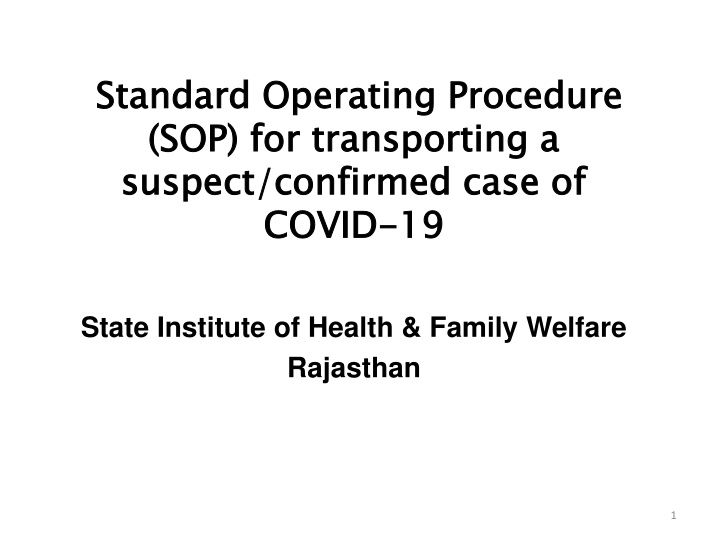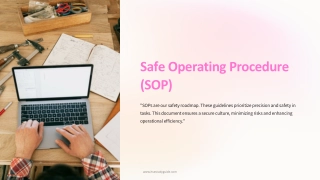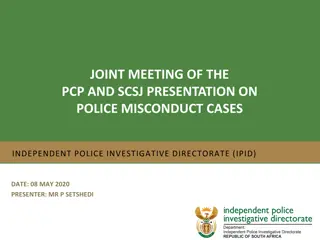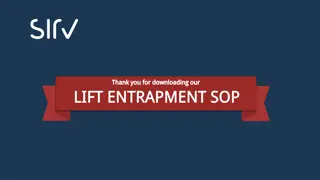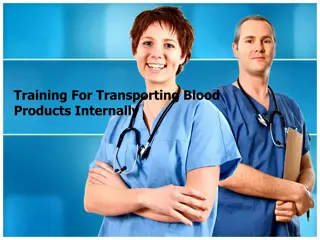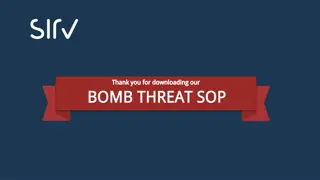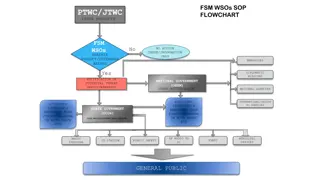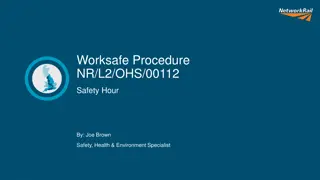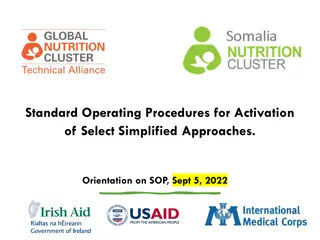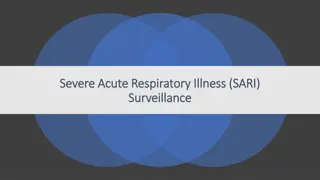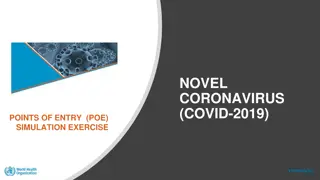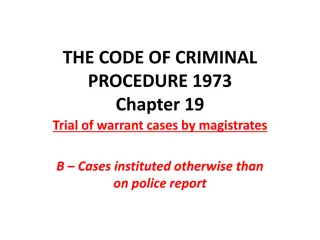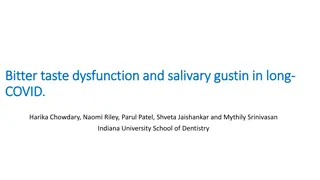Standard Operating Procedure (SOP) for Transporting COVID-19 Cases
This SOP outlines guidelines for safely transporting suspect or confirmed cases of COVID-19. It includes procedures for ambulance drivers and technicians, monitoring infection prevention protocols, and utilizing designated ambulances for patient transport. The document emphasizes the importance of minimizing transmission risks during transportation.
Download Presentation

Please find below an Image/Link to download the presentation.
The content on the website is provided AS IS for your information and personal use only. It may not be sold, licensed, or shared on other websites without obtaining consent from the author.If you encounter any issues during the download, it is possible that the publisher has removed the file from their server.
You are allowed to download the files provided on this website for personal or commercial use, subject to the condition that they are used lawfully. All files are the property of their respective owners.
The content on the website is provided AS IS for your information and personal use only. It may not be sold, licensed, or shared on other websites without obtaining consent from the author.
E N D
Presentation Transcript
Standard Operating Procedure (SOP) for transporting a suspect/confirmed case of COVID Standard Operating Procedure (SOP) for transporting a suspect/confirmed case of COVID- -19 19 State Institute of Health & Family Welfare Rajasthan 1
Need of The Need of The SoP SoP These procedures are meant to guide and be used for training of ambulance drivers and technicians in transporting COVID-19 patients. Also aim to support programme officers in monitoring functionality and infection prevention protocols of the ambulances. MOHFW-Coronavirus Disease 2019 (COVID-19): Standard Operating Procedure (SOP) for transporting a suspect/confirmed case of COVID-19 2
Introduction Introduction The transmission of COVID-19 can occur via respiratory droplets directly (through droplets from coughing or sneezing) or indirectly (through contaminated objects or surfaces). The people most at risk of COVID-19 infection are those who are in close contact with a suspect/confirmed COVID-19 patient and those who care for such patients. MOHFW-Coronavirus Disease 2019 (COVID-19): Standard Operating Procedure (SOP) for transporting a suspect/confirmed case of COVID-19 3
Transportation of Patients Transportation of Patients There should be ambulances identified specifically for transporting COVID suspect patients or those who have developed complications, to the health facilities. There are two types of ambulances ALS (with ventilators) and BLS (without ventilators). MOHFW-Coronavirus Disease 2019 (COVID-19): Standard Operating Procedure (SOP) for transporting a suspect/confirmed case of COVID-19 4
Ambulance with Ventilators Ambulance with Ventilators 5
Augmenting the capacity of ambulances in districts Augmenting the capacity of ambulances in districts Local authorities should prepare a line list of all private ambulance service providers in their respective areas. These ambulances should be linked with centralized call centre so as to ensure adequate number of ambulances based on population and time to care approach. Ambulances should be strategically located at hospitals, police stations. MOHFW-Coronavirus Disease 2019 (COVID-19): Standard Operating Procedure (SOP) for transporting a suspect/confirmed case of COVID-19 6
Only identified and designated ambulances should be used for transportation. Orientation on Infection Prevention Protocols and protocols for transporting COVID patients should also be ensured for staff of these ambulances. To minimize the risk of transmission, it is strongly recommended that if other than empanelled ambulances are bringing COVID or suspect patients, such vehicles need to be quarantined for thorough cleaning and disinfection and should only be released after certification by district administration/ district health official. MOHFW-Coronavirus Disease 2019 (COVID-19): Standard Operating Procedure (SOP) for transporting a suspect/confirmed case of COVID-19 7
Call Centre Call Centre The call centre needs to enquire following details: Demographic details of the patient i.e. name, age, gender etc To ascertain whether the patient is suspect case of COVID-19 Symptoms of patient: Ask whether the patient is suffering from fever, cough and difficulty in breathing Whether patient has recently returned from a foreign country Whether the patient was under home quarantine as directed by local health administration Annexure-1 Clinical condition of patient to be transported: whether stable or critical 8
Assign the job to nearest ambulance with dedicated facility at strategic locations as mentioned Check for state of preparedness of ambulance: Annexure II Ensure PPE for ambulance staff: Annexure III MOHFW-Coronavirus Disease 2019 (COVID-19): Standard Operating Procedure (SOP) for transporting a suspect/confirmed case of COVID-19 9
Both call centre and ambulances should always keep the updated list of available hospitals and beds 10
Role of EMT Role of EMT On receiving the call, from the call centre and prior to shifting the patient, EMT will perform following - To ensure whether the patient is a suspect case of COVID-19 EMT will wear the appropriate PPE Assess the condition of the patient If the patient is stable, he/she may be asked to board the ambulance otherwise the EMT (while using the prescribed PPE) may assist loading of patient. 11
Only one caregiver should be allowed to accompany the patient (while using the prescribed PPE). EMT should also ensure availability and provision of adequate triple layered mask and gloves for patient and/or attendant . The patient and the care giver will be provided with a triple layer medical mask. EMT will contact the identified health facility for preparedness and readiness. 12
Management on Board Management on Board Measure vitals of patient and ensure patient is stable If required, give supplementary O2 therapy at 5 L/min and titrate flow rates to reach target SpO2 90%. If patient is being transported on ventilator to a higher center, follow ventilator management protocols, provided the EMT is either trained or assisted by a doctor well versed in ventilator management 13
Handing over the Patient On reaching the receiving hospital, the EMT will hand over the patient and details of medical interventions if any during transport. After handing over the patient, the PPEs will be taken off as per protocol followed by hand washing. The biomedical waste generated (including PPE) to be disposed off in a bio-hazard bag (yellow bag). Inside would be sprayed with Sodium Hypochlorite (1%) and after tying the exterior will also be sprayed with the same. It would be disposed off at their destination hospital. This shall again be followed by hand washing. Handing over the Patient 14
Disinfection of Ambulance Disinfection of Ambulance All surfaces that may have come in contact with the patient or materials contaminated during patient care (e.g., stretcher, rails, control panels, floors, walls and work surfaces) should be thoroughly cleaned and disinfected using 1% Sodium Hypochlorite solution. (Annexure IV for preparation of 1% Sodium hypochlorite solution) 15
Clean and disinfect reusable patient-care equipment before use on another patient with alcohol based rub Cleaning of all surfaces and equipment should be done morning, evening and after every use with soap/detergent and water MOHFW-Coronavirus Disease 2019 (COVID-19): Standard Operating Procedure (SOP) for transporting a suspect/confirmed case of COVID-19 16
Capacity Building District Authorities to ensure capacity building of EMT and driver on following areas :- Donning and doffing of PPE Infection Prevention Protocols Annexure V Triaging and identifying COVID-19 suspects based on their signs and symptoms Trained in segregation, management of COVID-19 patients. They should not be mixed with other patients. Capacity Building isolation and MOHFW-Coronavirus Disease 2019 (COVID-19): Standard Operating Procedure (SOP) for transporting a suspect/confirmed case of COVID-19 17
Monitoring Monitoring A checklist for weekly monitoring by District Surgeon/ Anesthetist is Annexure VI MOHFW-Coronavirus Disease 2019 (COVID-19): Standard Operating Procedure (SOP) for transporting a suspect/confirmed case of COVID-19 18
Thank You 19
